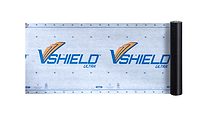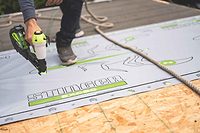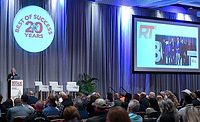New ASTM Standard Tests the Performance of Synthetic Underlayments

Photo courtesy of Owens Corning.
Synthetic underlayments are growing in popularity among roofing contractors thanks to being lightweight and stronger than felt, but tests for ensuring they’re products that will perform as expected have been a bit lackluster.
That may all change soon, as ASTM International published its first U.S. product standard for synthetic underlayments, ASTM D8257, in December 2020, and roofing contractors wanting quality products should keep an eye out for compliant underlayments in the coming months.
When synthetic underlayments first hit the market, there were no standard test methods for determining their suitability as a proper roofing underlayment. Instead, they were tested using longstanding asphalt felt underlayment standards ASTM D226 and ASTM D4869.
These standards, however, rely on composition, and since synthetics are composed of different materials, the performance requirements don’t translate.
“When you’re testing these products in correlation with those standards, those standards are primarily asphalt standards that are recipe standards — in other words, they require a certain level of asphalt content, a certain level of felt weight and composition, and so they aren’t an apples-to-apples comparison to this category of products,” said Greg Keeler, technical services leader with Owens Corning.
Roofing associations like the National Roofing Contractors Association, Western States Roofing Contractors Association and Florida Roofing and Sheet Metal Contractors Association have encouraged the industry to adopt new standards for synthetics. With that in mind, Owens Corning has spent the last eight years spearheading the creation of ASTM D8257, titled “Standard Specification for Mechanically Attached Polymeric Roof Underlayment Used in Steep Slope Roofing.”
Various industry stakeholders have been involved in the process. Kal Kooner from Intertek was Keeler’s co-chair on the Task Group. Along with the associations previously mentioned, various underlayment manufacturers, third-party test labs, and general interest (architects, engineers, and roof consultants) played a role as well.
“There wasn’t any real objection to creating the standard, but there were a lot of objections along the way with respect to what we wanted to incorporate into the standard and the levels of performance that the standard would require,” Keeler said.
Setting the Standard
Current felt standards test for unrolling, tensile strength and pliability, but don’t include other important aspects. ASTM D8257 accounts for those requirements that current ASTM standards don’t, including liquid water transmission, accelerated weathering, and thermal cycling.
“We wanted to level the playing field and get everybody on the same page and give the customers a product that we feel confident will perform,” Keeler said. “It’s definitely a positive step for the roofing industry and for homeowners because it provides a lot better product choices in the market.”
Keeler said over 50 competitive synthetic underlayment products were tested in creating the standard. Brand new synthetic underlayment is used in the testing to show how the product performs in everything from tear strength to water vapor transmission.
To see how products perform in real-world settings without having to wait for Mother Nature, underlayments are placed in a xenon arc weathering chamber for 500 hours to simulate 30 days of outdoor exposure. This lab-accelerated weathering shows how the products stand up to conditions like solar radiation and moisture prior to having the primary roof material installed over them.
“They are exposed to a lot of the rigors that they would be exposed to in the field in actual application,” Keeler said.
Code Adoption
As of now, ASTM D8257 hasn’t been included in building codes like the International Building Code or International Residential Code. Owens Corning has already begun the process of proposing that ASTM D8257 be incorporated into the 2024 I-Codes and the 2023 Florida Building Code.
The effort is expanding beyond the United States. Keeler is chairing a task group with the Canadian Standards Association that aims to recommend the new standard to the National Building Code of Canada in 2025.
Even though the code isn’t officially included, using synthetic underlayments could be advantageous to roofing contractors during supply shortages. Synthetic underlayments are tested for extreme exposure conditions, so if installed on a roof, it’ll help protect the building while primary roofing products are en route.
“If you need to get the roof dried in, they are built to last for up to 180 days in some cases,” Keeler said. “If you’re making choices with respects to synthetic underlayments, you should be choosing products that are demonstrating compliance with this standard.”
Looking for a reprint of this article?
From high-res PDFs to custom plaques, order your copy today!






